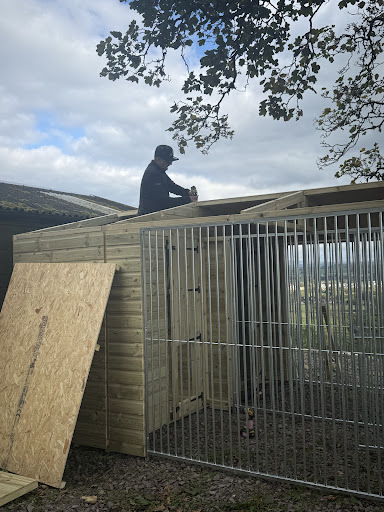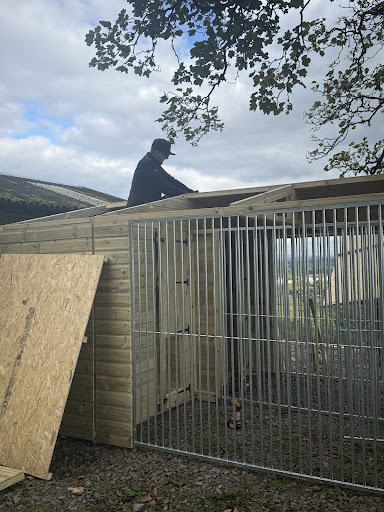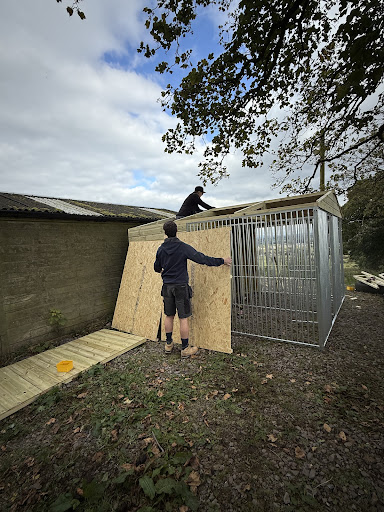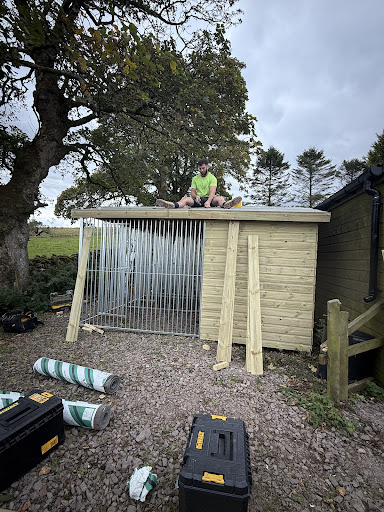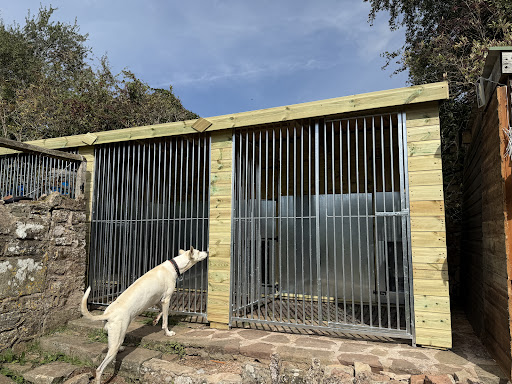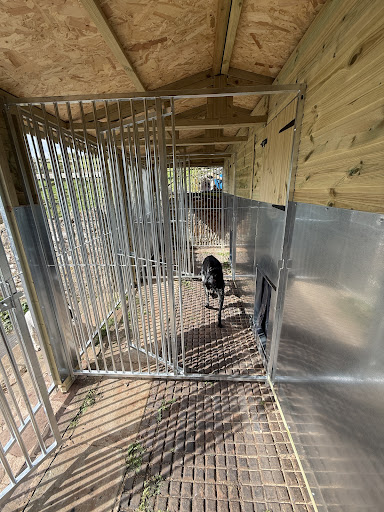If you’ve ever asked yourself if kennels are good for your dog, you’re not alone. Many first-time dog owners worry that crates or kennels are restrictive or unfair, but in truth, they offer huge benefits for both dogs and their humans. When introduced properly, a kennel, whether indoors or outdoors, becomes a calm, safe retreat that supports your dog’s health, behaviour, and training. There are many benefits of kennels for dogs, especially when used in a positive and structured way. Both crates and garden kennels can help with house training, reduce anxiety, assist recovery, and give dogs a strong sense of security. In fact, one survey conducted among trainers and veterinarians indicates that approximately 70% of dog owners said crate training made housebreaking much easier.
Kennels also give owners peace of mind. When your dog has a space that is just for them, it becomes easier to manage their behaviour and daily routine. Kennels can prevent chewing, indoor accidents, and anxious pacing, which often result from overstimulation or lack of boundaries. For busy households, having a dedicated space means your dog doesn’t get overwhelmed or underfoot, especially during chaotic moments like mealtimes or when guests arrive. These practical benefits make kennel training a helpful tool in everyday dog care, not just during training stages.
Why Vets and Breeders Recommend Kennel and Crate Training
Most vets, dog trainers, and responsible breeders suggest starting kennel training early in a dog’s life because it fits naturally with how dogs behave. They often look for small, enclosed spaces where they can feel calm and secure, similar to a den in the wild. When done the right way, a crate or kennel becomes a familiar and comforting space they can return to whenever they need rest or a break from the busy world around them.
Kennels are helpful during important times such as toilet training, where puppies learn how to hold their bladder and stick to a routine. They are also useful for recovery after surgery, helping dogs stay still and heal without further injury. In emergencies, having a dog that is comfortable with a crate or kennel makes things safer and quicker for everyone. Kennels also help dogs settle during loud events like fireworks or when lots of visitors are around. Most professionals agree that early, gentle training using a crate or kennel helps dogs grow into calm, adaptable pets.
In breeding and veterinary settings, kennels are used daily. For breeders, they allow for safe separation of litters and adult dogs. For vets, kennels are often where dogs are placed after surgery or during hospital stays, so a dog already familiar with a kennel setup is likely to experience much less stress in those environments.
What Is a Dog Crate or Kennel?
A dog crate, sometimes called a playpen or indoor kennel, is a safe space where your dog can relax. Most indoor crates are made of metal or plastic and come in different sizes for different dog breeds. An outdoor kennel, usually placed in a garden or yard, gives dogs their own space outside the home that is safe and comfortable.
Both types should be big enough for your dog to stand up, turn around, and lie down with ease. For puppies, it’s a good idea to pick one they can grow into. For travelling or short-term rest, a smaller option may be safer. Kennels should be kept clean, well-ventilated, and placed in a quiet, comfortable area that avoids direct sun or extreme temperatures.
Crates can be made more inviting with soft bedding, toys, and even a blanket partially draped over the top to help create a more enclosed, cosy feeling. Many dogs come to view this space as their own private retreat, where they feel safe and settled, even when the household is active.
Everyday Uses: Why Kennels Are Good in Daily Life
There are many reasons why kennels are good. Both indoor crates and outdoor kennels are useful for giving dogs a place to relax when life gets busy. A kennel works like a peaceful den, helping dogs rest and recharge away from household noise. It also supports toilet training by helping dogs learn when and where to go.
Vets often recommend using kennels when dogs are recovering from illness or surgery, as they encourage quiet time and prevent them from moving too much. Kennels also make travel safer and more manageable, whether in the car or when staying somewhere new. And when you’re cooking, cleaning, or welcoming guests, a crate or kennel gives your dog a place to stay calm and out of harm’s way.
The benefits of kennels for dogs include better behaviour, more confidence, and less stress. They also help build a healthy sense of routine. Dogs do well when they know what to expect, and kennel time can be part of that daily rhythm, just like walks, meals, and bedtime.
Kennels Support Dogs of All Ages and Backgrounds
Kennel training is helpful for dogs at every stage of life. Puppies can learn house training more quickly and stay safe when you’re busy or not watching closely. Adult dogs enjoy having a place to unwind when the house is noisy or active. Older dogs, especially those with sore joints or memory problems, often feel more at ease in a space that’s quiet and predictable.
Rescue dogs who may have faced stress or change before often feel more settled when they have their own kennel space. For large dogs or working breeds, having a defined area can lower anxiety and prevent overprotective habits. From crates inside the house to outdoor garden kennels, offering a quiet place helps dogs of all kinds feel calm and secure.
Kennels are especially helpful in multi-dog households. They allow each dog to have their own personal space, which reduces tension and supports better social behaviour. By rotating kennel time with shared play and training, you give your dog the right balance of stimulation and rest.
How to Train Your Dog to Use a Crate or Kennel
Teaching your dog to enjoy their crate or kennel takes time and patience. The goal is to help them see it as a safe and positive place. Follow these simple steps to build comfort and trust.
Step 1: Introducing the Crate or Kennel
Start by placing the crate in a space where your family often spends time. If it’s an outdoor kennel, let your dog explore it freely with the door propped open. Add treats or toys inside to spark their interest. Use a kind, cheerful voice and let your dog take the lead. Keep early sessions short, just a few minutes at a time. Some dogs get comfortable quickly, while others may take a few days.
Step 2: Building Time in the Kennel
Once your dog walks in happily, begin offering meals inside the crate or kennel. Put the food bowl at the back so they fully enter. Gently close the door while they eat, and open it again once they’re done. With each meal, try keeping the door shut a bit longer. If your dog becomes nervous, step back and go more slowly until they’re ready to continue.
Step 3: Practising Time Apart
When your dog is happy being inside with the door shut, begin short periods where you leave the room. Offer them a safe chew or stuffed toy to enjoy while you step away for a few minutes. Come back calmly and praise them quietly. Do this several times a day, making each session a little longer. Over time, they’ll learn that being alone is okay and that their kennel or crate is a relaxing place to wait. Once your dog is comfortable staying alone for up to 30 minutes, you can start using it when you leave the house for short outings.
Why Kennels Are Good for Dogs
In conclusion, knowing why kennels are good for dogs helps you understand how they support daily life and long-term behaviour. Crates and outdoor kennels help with house training, calm recovery, and stressful moments like loud noises or guests. They offer comfort, security, and a space that dogs can truly call their own.
For dog owners, kennel training also brings peace of mind. It gives you the confidence to leave your pet safely for short periods without worry. Kennels are not just helpful, they are part of thoughtful care and responsible ownership. If you’re looking to give your dog a space that supports their health and happiness, take a look at the quality options available from Benchmark Kennels, where your dog’s comfort always matters most.
Are kennels cruel for dogs?
No. When introduced correctly, kennels provide a safe, secure space that dogs can call their own. Most dogs naturally seek enclosed areas to rest—similar to a den in the wild—so a well-used kennel offers comfort, not confinement.
What’s the difference between a crate and a kennel?
A crate is usually an indoor space, often made from plastic or metal, used for rest, travel, or short-term confinement. A kennel can refer to either an outdoor structure or a more permanent setup, offering dogs their own space in the garden or yard.
How long can I leave my dog in a crate?
For adult dogs, 4–6 hours at a time is generally acceptable during the day. Puppies should spend less time inside based on their age (about 1 hour per month of age). Overnight use is fine as long as the dog is comfortable and has regular access to water and breaks.
Is crate training good for puppies?
Yes. Crate training helps with toilet training, builds routine, and prevents accidents or destructive chewing. When introduced gently, crates help puppies feel calm and safe.
Can kennels help with separation anxiety?
Yes. Kennels provide structure and a familiar retreat, which can ease anxiety when dogs are left alone. When used with proper training and enrichment, they help dogs feel more secure during short absences.














